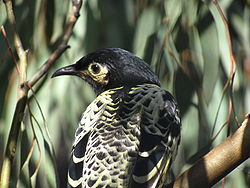22:
208:
87:
as well as private land. The area experiences average daily temperatures ranging from 2-13 °C in winter to 15-30 °C in summer, with an average annual rainfall of 620 mm.
169:
281:
252:
271:
276:
245:
238:
215:
33:
226:
80:
84:
61:
53:
57:
49:
130:
BirdLife
International. (2011). Important Bird Areas factsheet: Mudgee-Wollar. Downloaded from
96:
8:
64:
103:
76:
107:
37:
222:
265:
184:
171:
111:
207:
100:
218:
41:
144:
21:
75:
The IBA consists of, and is defined by, woodland remnants used by
45:
131:
25:
The IBA is an important site for regent honeyeaters
16:Important Bird Area in New South Wales, Australia
263:
114:in the north-westernmost part of their range.
282:Central West, New South Wales geography stubs
246:
253:
239:
99:as an IBA because it regularly supports
48:, extending eastwards from the towns of
20:
272:Important Bird Areas of New South Wales
32:is a 1627 km tract of land in the
264:
60:. At its eastern end it adjoins the
202:
44:. It lies about 250 km west of
13:
14:
293:
30:Mudgee-Wollar Important Bird Area
206:
95:The area has been identified by
56:, and encompassing the town of
277:Central West (New South Wales)
137:
124:
106:, as well as small numbers of
70:
1:
117:
225:. You can help Knowledge by
81:Goulburn River National Park
7:
85:Munghorn Gap Nature Reserve
10:
298:
201:
90:
132:http://www.birdlife.org
185:32.35444°S 149.91222°E
97:BirdLife International
62:Greater Blue Mountains
26:
24:
190:-32.35444; 149.91222
145:"IBA: Mudgee-Wollar"
181: /
79:. It includes the
65:Important Bird Area
34:Central West region
104:regent honeyeaters
77:regent honeyeaters
27:
234:
233:
151:. Birds Australia
108:diamond firetails
289:
255:
248:
241:
210:
203:
196:
195:
193:
192:
191:
186:
182:
179:
178:
177:
174:
161:
160:
158:
156:
141:
135:
128:
297:
296:
292:
291:
290:
288:
287:
286:
262:
261:
260:
259:
199:
189:
187:
183:
180:
175:
172:
170:
168:
167:
165:
164:
154:
152:
143:
142:
138:
129:
125:
120:
93:
73:
38:New South Wales
17:
12:
11:
5:
295:
285:
284:
279:
274:
258:
257:
250:
243:
235:
232:
231:
211:
163:
162:
136:
134:on 22/08/2011.
122:
121:
119:
116:
92:
89:
72:
69:
15:
9:
6:
4:
3:
2:
294:
283:
280:
278:
275:
273:
270:
269:
267:
256:
251:
249:
244:
242:
237:
236:
230:
228:
224:
221:article is a
220:
217:
212:
209:
205:
204:
200:
197:
194:
150:
146:
140:
133:
127:
123:
115:
113:
109:
105:
102:
98:
88:
86:
82:
78:
68:
66:
63:
59:
55:
51:
47:
43:
39:
35:
31:
23:
19:
227:expanding it
216:Central West
213:
198:
166:
153:. Retrieved
148:
139:
126:
112:rockwarblers
94:
74:
29:
28:
18:
188: /
176:149°54′44″E
71:Description
266:Categories
173:32°21′16″S
118:References
101:endangered
219:geography
155:22 August
42:Australia
83:and the
149:Birdata
67:(IBA).
54:Gulgong
110:, and
58:Wollar
50:Mudgee
46:Sydney
214:This
91:Birds
223:stub
157:2011
52:and
36:of
268::
147:.
40:,
254:e
247:t
240:v
229:.
159:.
Text is available under the Creative Commons Attribution-ShareAlike License. Additional terms may apply.
